Economics Assignment: Macroeconomic Analysis, Trade and Policy Impact
VerifiedAdded on 2023/03/17
|19
|3198
|20
Homework Assignment
AI Summary
This economics assignment, completed for a Bachelor of Applied Management course, comprehensively addresses key macroeconomic concepts and their applications. Section A focuses on macroeconomic models, including CPI and GDP calculations, and their limitations. Section B explores the AD-AS model, analyzing the effects of net migration, GDP, inflation, and unemployment, as well as recessionary and inflationary gaps. Section C examines the impact of government policies on macroeconomic objectives, detailing monetary and fiscal policies and their effects on the New Zealand economy. Finally, Section D delves into international trade, comparative advantage, balance of payments, and foreign exchange, providing a detailed analysis of these critical global economic factors. The assignment includes calculations, graphical representations, and analyses of various economic scenarios.

ECONOMIC ASSIGNMENT
Name:
Institution:
Date:
Name:
Institution:
Date:
Paraphrase This Document
Need a fresh take? Get an instant paraphrase of this document with our AI Paraphraser
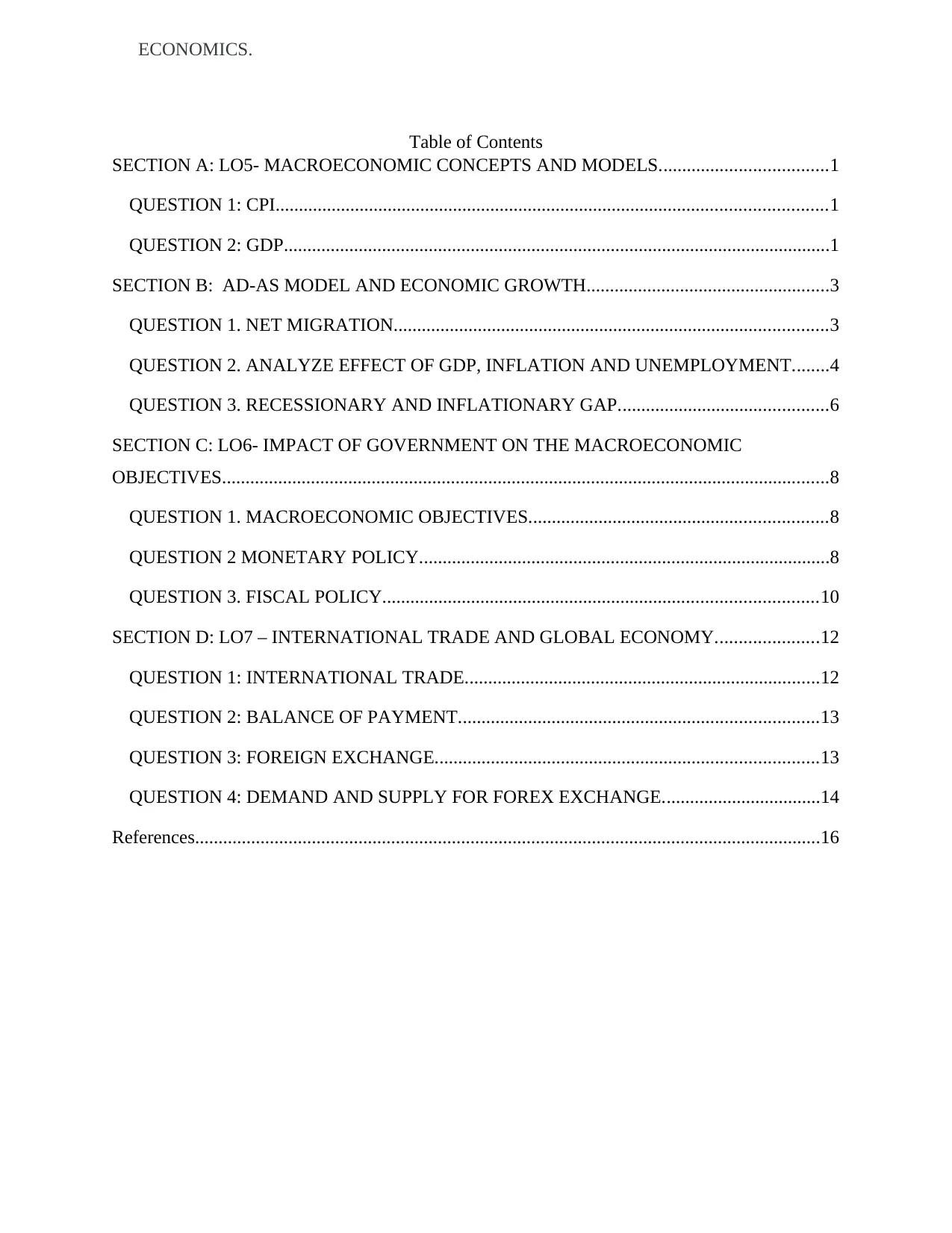
ECONOMICS.
Table of Contents
SECTION A: LO5- MACROECONOMIC CONCEPTS AND MODELS....................................1
QUESTION 1: CPI......................................................................................................................1
QUESTION 2: GDP.....................................................................................................................1
SECTION B: AD-AS MODEL AND ECONOMIC GROWTH....................................................3
QUESTION 1. NET MIGRATION.............................................................................................3
QUESTION 2. ANALYZE EFFECT OF GDP, INFLATION AND UNEMPLOYMENT........4
QUESTION 3. RECESSIONARY AND INFLATIONARY GAP.............................................6
SECTION C: LO6- IMPACT OF GOVERNMENT ON THE MACROECONOMIC
OBJECTIVES..................................................................................................................................8
QUESTION 1. MACROECONOMIC OBJECTIVES................................................................8
QUESTION 2 MONETARY POLICY........................................................................................8
QUESTION 3. FISCAL POLICY.............................................................................................10
SECTION D: LO7 – INTERNATIONAL TRADE AND GLOBAL ECONOMY......................12
QUESTION 1: INTERNATIONAL TRADE............................................................................12
QUESTION 2: BALANCE OF PAYMENT.............................................................................13
QUESTION 3: FOREIGN EXCHANGE..................................................................................13
QUESTION 4: DEMAND AND SUPPLY FOR FOREX EXCHANGE..................................14
References......................................................................................................................................16
Table of Contents
SECTION A: LO5- MACROECONOMIC CONCEPTS AND MODELS....................................1
QUESTION 1: CPI......................................................................................................................1
QUESTION 2: GDP.....................................................................................................................1
SECTION B: AD-AS MODEL AND ECONOMIC GROWTH....................................................3
QUESTION 1. NET MIGRATION.............................................................................................3
QUESTION 2. ANALYZE EFFECT OF GDP, INFLATION AND UNEMPLOYMENT........4
QUESTION 3. RECESSIONARY AND INFLATIONARY GAP.............................................6
SECTION C: LO6- IMPACT OF GOVERNMENT ON THE MACROECONOMIC
OBJECTIVES..................................................................................................................................8
QUESTION 1. MACROECONOMIC OBJECTIVES................................................................8
QUESTION 2 MONETARY POLICY........................................................................................8
QUESTION 3. FISCAL POLICY.............................................................................................10
SECTION D: LO7 – INTERNATIONAL TRADE AND GLOBAL ECONOMY......................12
QUESTION 1: INTERNATIONAL TRADE............................................................................12
QUESTION 2: BALANCE OF PAYMENT.............................................................................13
QUESTION 3: FOREIGN EXCHANGE..................................................................................13
QUESTION 4: DEMAND AND SUPPLY FOR FOREX EXCHANGE..................................14
References......................................................................................................................................16
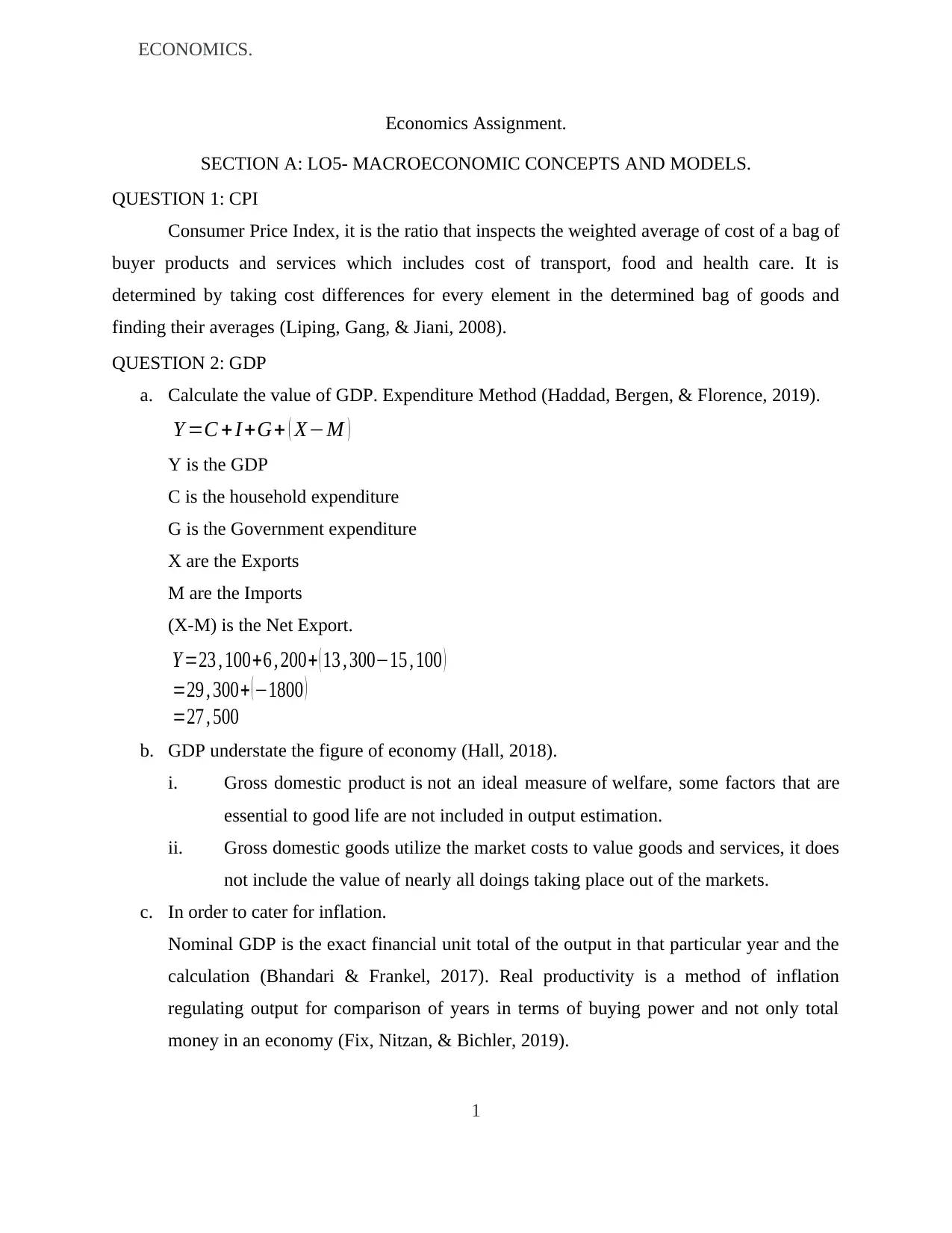
ECONOMICS.
Economics Assignment.
SECTION A: LO5- MACROECONOMIC CONCEPTS AND MODELS.
QUESTION 1: CPI
Consumer Price Index, it is the ratio that inspects the weighted average of cost of a bag of
buyer products and services which includes cost of transport, food and health care. It is
determined by taking cost differences for every element in the determined bag of goods and
finding their averages (Liping, Gang, & Jiani, 2008).
QUESTION 2: GDP
a. Calculate the value of GDP. Expenditure Method (Haddad, Bergen, & Florence, 2019).
Y =C + I +G+ ( X−M )
Y is the GDP
C is the household expenditure
G is the Government expenditure
X are the Exports
M are the Imports
(X-M) is the Net Export.
Y =23 , 100+6 , 200+ ( 13 , 300−15 , 100 )
=29 , 300+ ( −1800 )
=27 , 500
b. GDP understate the figure of economy (Hall, 2018).
i. Gross domestic product is not an ideal measure of welfare, some factors that are
essential to good life are not included in output estimation.
ii. Gross domestic goods utilize the market costs to value goods and services, it does
not include the value of nearly all doings taking place out of the markets.
c. In order to cater for inflation.
Nominal GDP is the exact financial unit total of the output in that particular year and the
calculation (Bhandari & Frankel, 2017). Real productivity is a method of inflation
regulating output for comparison of years in terms of buying power and not only total
money in an economy (Fix, Nitzan, & Bichler, 2019).
1
Economics Assignment.
SECTION A: LO5- MACROECONOMIC CONCEPTS AND MODELS.
QUESTION 1: CPI
Consumer Price Index, it is the ratio that inspects the weighted average of cost of a bag of
buyer products and services which includes cost of transport, food and health care. It is
determined by taking cost differences for every element in the determined bag of goods and
finding their averages (Liping, Gang, & Jiani, 2008).
QUESTION 2: GDP
a. Calculate the value of GDP. Expenditure Method (Haddad, Bergen, & Florence, 2019).
Y =C + I +G+ ( X−M )
Y is the GDP
C is the household expenditure
G is the Government expenditure
X are the Exports
M are the Imports
(X-M) is the Net Export.
Y =23 , 100+6 , 200+ ( 13 , 300−15 , 100 )
=29 , 300+ ( −1800 )
=27 , 500
b. GDP understate the figure of economy (Hall, 2018).
i. Gross domestic product is not an ideal measure of welfare, some factors that are
essential to good life are not included in output estimation.
ii. Gross domestic goods utilize the market costs to value goods and services, it does
not include the value of nearly all doings taking place out of the markets.
c. In order to cater for inflation.
Nominal GDP is the exact financial unit total of the output in that particular year and the
calculation (Bhandari & Frankel, 2017). Real productivity is a method of inflation
regulating output for comparison of years in terms of buying power and not only total
money in an economy (Fix, Nitzan, & Bichler, 2019).
1
⊘ This is a preview!⊘
Do you want full access?
Subscribe today to unlock all pages.

Trusted by 1+ million students worldwide
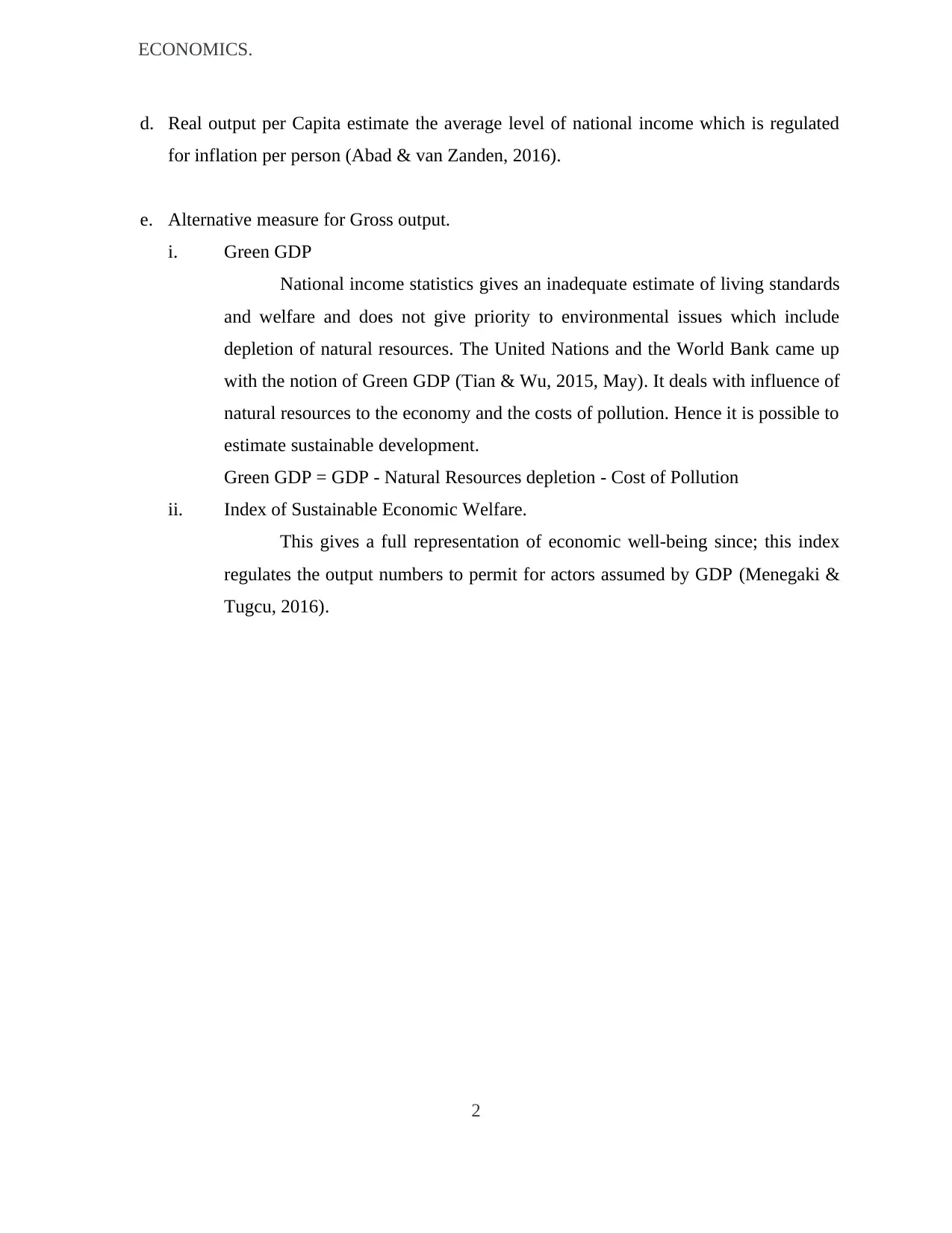
ECONOMICS.
d. Real output per Capita estimate the average level of national income which is regulated
for inflation per person (Abad & van Zanden, 2016).
e. Alternative measure for Gross output.
i. Green GDP
National income statistics gives an inadequate estimate of living standards
and welfare and does not give priority to environmental issues which include
depletion of natural resources. The United Nations and the World Bank came up
with the notion of Green GDP (Tian & Wu, 2015, May). It deals with influence of
natural resources to the economy and the costs of pollution. Hence it is possible to
estimate sustainable development.
Green GDP = GDP - Natural Resources depletion - Cost of Pollution
ii. Index of Sustainable Economic Welfare.
This gives a full representation of economic well-being since; this index
regulates the output numbers to permit for actors assumed by GDP (Menegaki &
Tugcu, 2016).
2
d. Real output per Capita estimate the average level of national income which is regulated
for inflation per person (Abad & van Zanden, 2016).
e. Alternative measure for Gross output.
i. Green GDP
National income statistics gives an inadequate estimate of living standards
and welfare and does not give priority to environmental issues which include
depletion of natural resources. The United Nations and the World Bank came up
with the notion of Green GDP (Tian & Wu, 2015, May). It deals with influence of
natural resources to the economy and the costs of pollution. Hence it is possible to
estimate sustainable development.
Green GDP = GDP - Natural Resources depletion - Cost of Pollution
ii. Index of Sustainable Economic Welfare.
This gives a full representation of economic well-being since; this index
regulates the output numbers to permit for actors assumed by GDP (Menegaki &
Tugcu, 2016).
2
Paraphrase This Document
Need a fresh take? Get an instant paraphrase of this document with our AI Paraphraser
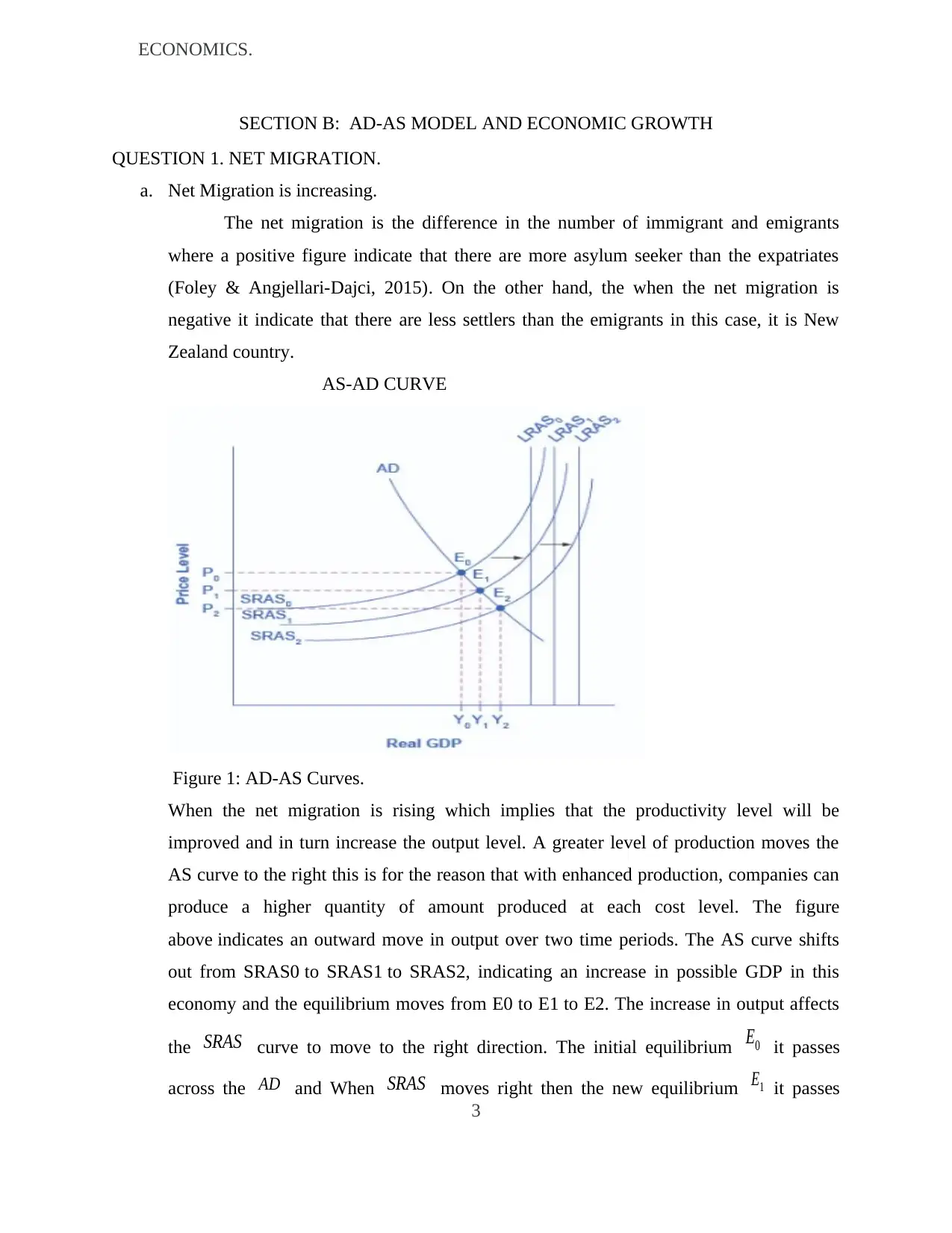
ECONOMICS.
SECTION B: AD-AS MODEL AND ECONOMIC GROWTH
QUESTION 1. NET MIGRATION.
a. Net Migration is increasing.
The net migration is the difference in the number of immigrant and emigrants
where a positive figure indicate that there are more asylum seeker than the expatriates
(Foley & Angjellari-Dajci, 2015). On the other hand, the when the net migration is
negative it indicate that there are less settlers than the emigrants in this case, it is New
Zealand country.
AS-AD CURVE
Figure 1: AD-AS Curves.
When the net migration is rising which implies that the productivity level will be
improved and in turn increase the output level. A greater level of production moves the
AS curve to the right this is for the reason that with enhanced production, companies can
produce a higher quantity of amount produced at each cost level. The figure
above indicates an outward move in output over two time periods. The AS curve shifts
out from SRAS0 to SRAS1 to SRAS2, indicating an increase in possible GDP in this
economy and the equilibrium moves from E0 to E1 to E2. The increase in output affects
the SRAS curve to move to the right direction. The initial equilibrium E0 it passes
across the AD and When SRAS moves right then the new equilibrium E1 it passes
3
SECTION B: AD-AS MODEL AND ECONOMIC GROWTH
QUESTION 1. NET MIGRATION.
a. Net Migration is increasing.
The net migration is the difference in the number of immigrant and emigrants
where a positive figure indicate that there are more asylum seeker than the expatriates
(Foley & Angjellari-Dajci, 2015). On the other hand, the when the net migration is
negative it indicate that there are less settlers than the emigrants in this case, it is New
Zealand country.
AS-AD CURVE
Figure 1: AD-AS Curves.
When the net migration is rising which implies that the productivity level will be
improved and in turn increase the output level. A greater level of production moves the
AS curve to the right this is for the reason that with enhanced production, companies can
produce a higher quantity of amount produced at each cost level. The figure
above indicates an outward move in output over two time periods. The AS curve shifts
out from SRAS0 to SRAS1 to SRAS2, indicating an increase in possible GDP in this
economy and the equilibrium moves from E0 to E1 to E2. The increase in output affects
the SRAS curve to move to the right direction. The initial equilibrium E0 it passes
across the AD and When SRAS moves right then the new equilibrium E1 it passes
3
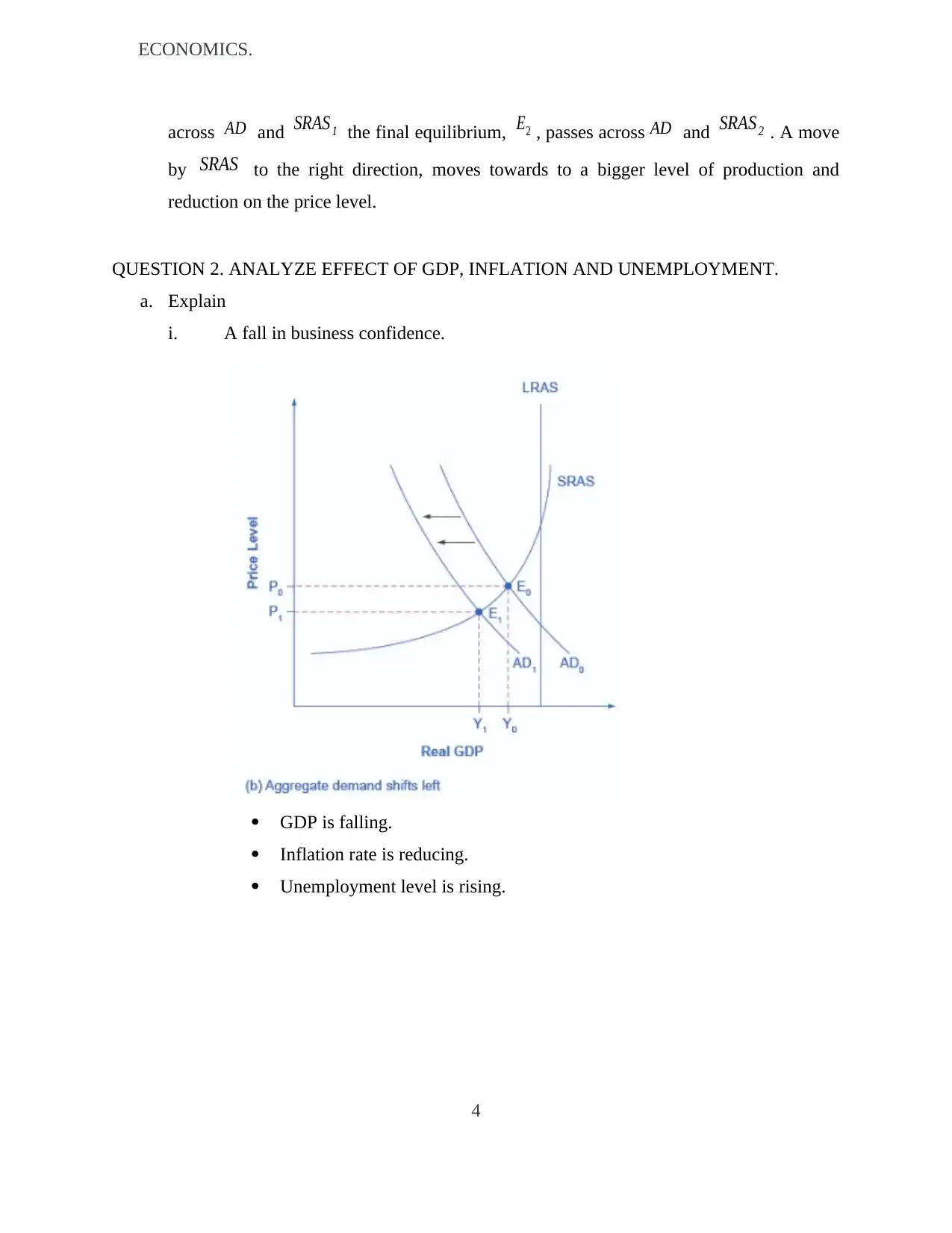
ECONOMICS.
across AD and SRAS 1 the final equilibrium, E2 , passes across AD and SRAS 2 . A move
by SRAS to the right direction, moves towards to a bigger level of production and
reduction on the price level.
QUESTION 2. ANALYZE EFFECT OF GDP, INFLATION AND UNEMPLOYMENT.
a. Explain
i. A fall in business confidence.
GDP is falling.
Inflation rate is reducing.
Unemployment level is rising.
4
across AD and SRAS 1 the final equilibrium, E2 , passes across AD and SRAS 2 . A move
by SRAS to the right direction, moves towards to a bigger level of production and
reduction on the price level.
QUESTION 2. ANALYZE EFFECT OF GDP, INFLATION AND UNEMPLOYMENT.
a. Explain
i. A fall in business confidence.
GDP is falling.
Inflation rate is reducing.
Unemployment level is rising.
4
⊘ This is a preview!⊘
Do you want full access?
Subscribe today to unlock all pages.

Trusted by 1+ million students worldwide
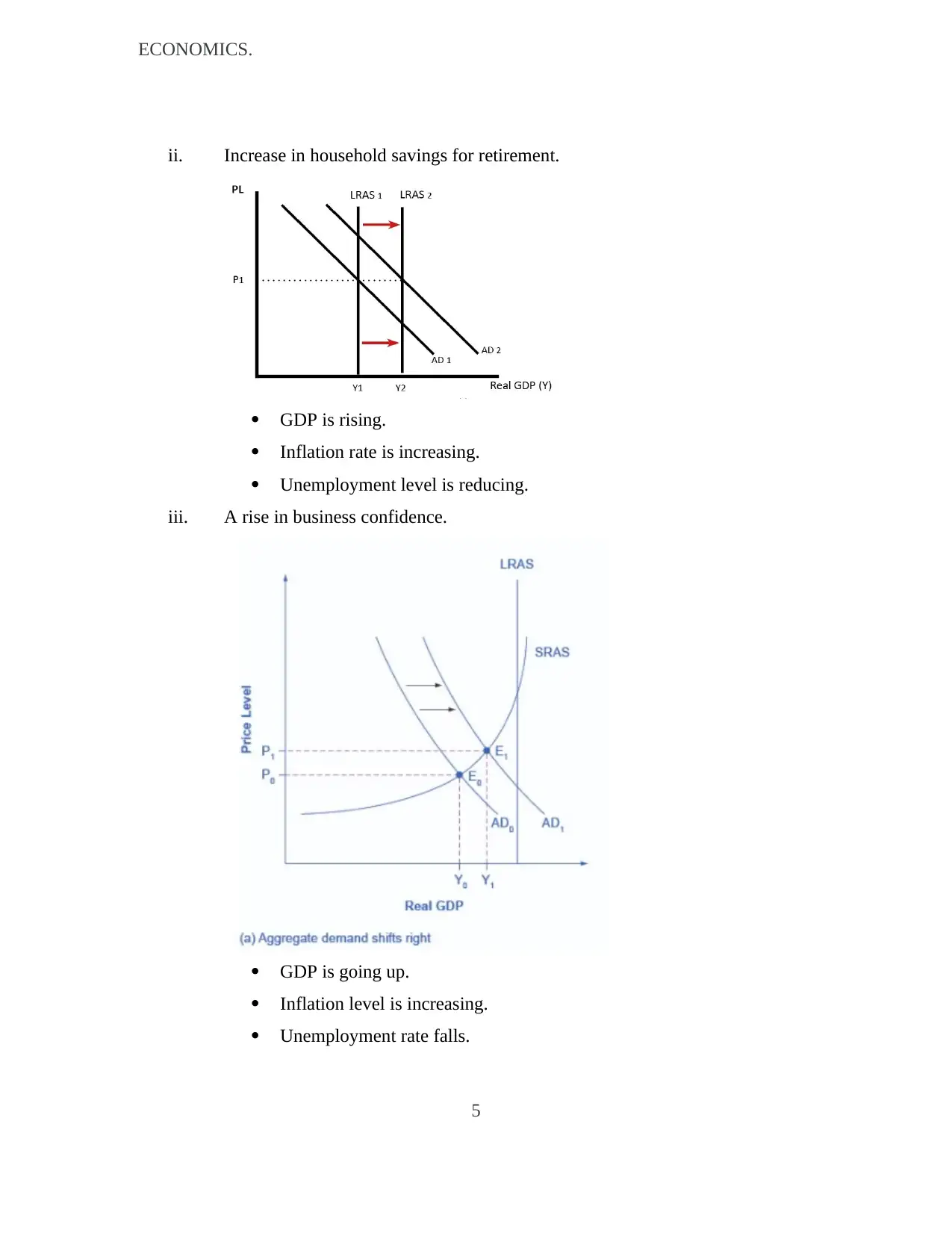
ECONOMICS.
ii. Increase in household savings for retirement.
GDP is rising.
Inflation rate is increasing.
Unemployment level is reducing.
iii. A rise in business confidence.
GDP is going up.
Inflation level is increasing.
Unemployment rate falls.
5
ii. Increase in household savings for retirement.
GDP is rising.
Inflation rate is increasing.
Unemployment level is reducing.
iii. A rise in business confidence.
GDP is going up.
Inflation level is increasing.
Unemployment rate falls.
5
Paraphrase This Document
Need a fresh take? Get an instant paraphrase of this document with our AI Paraphraser
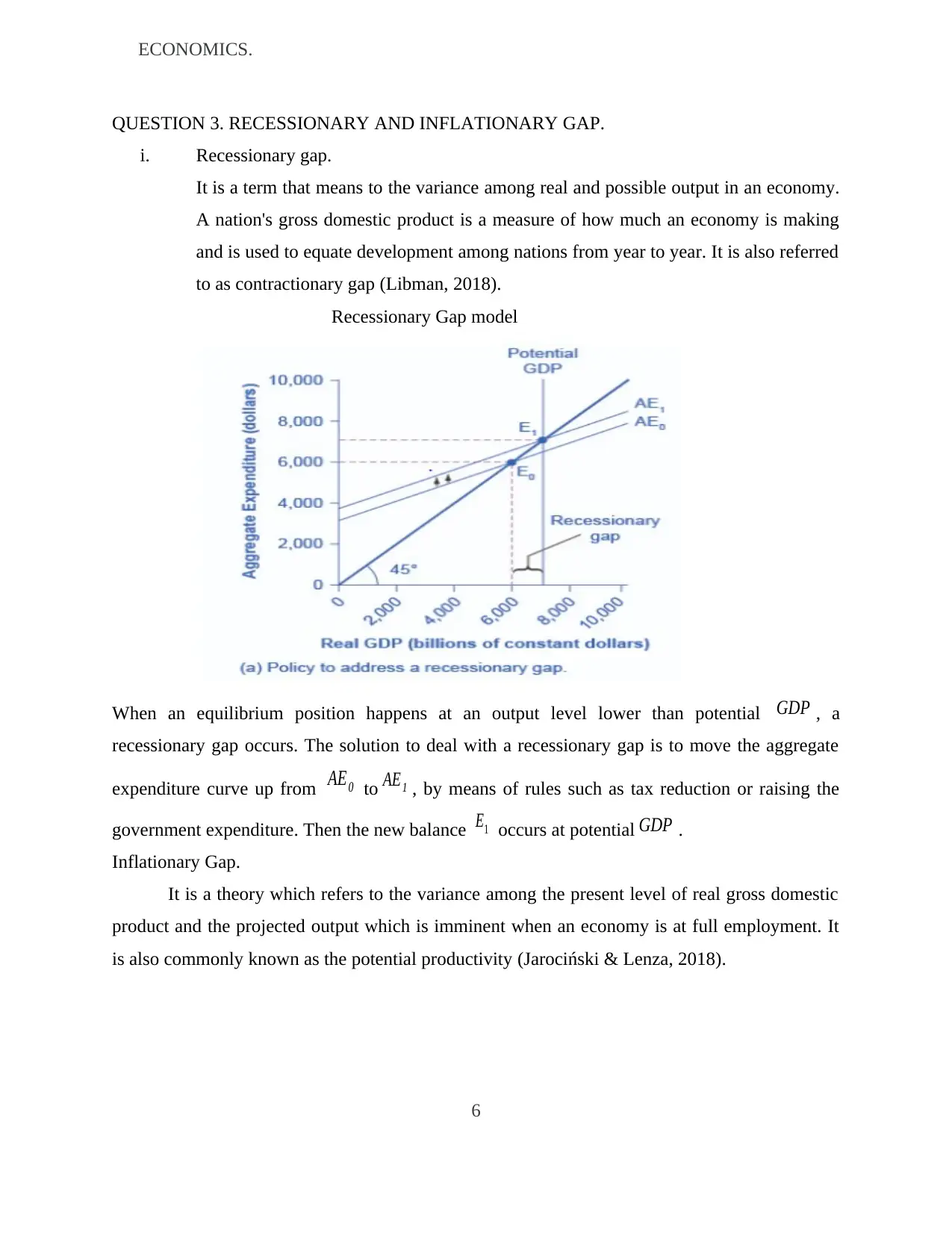
ECONOMICS.
QUESTION 3. RECESSIONARY AND INFLATIONARY GAP.
i. Recessionary gap.
It is a term that means to the variance among real and possible output in an economy.
A nation's gross domestic product is a measure of how much an economy is making
and is used to equate development among nations from year to year. It is also referred
to as contractionary gap (Libman, 2018).
Recessionary Gap model
When an equilibrium position happens at an output level lower than potential GDP , a
recessionary gap occurs. The solution to deal with a recessionary gap is to move the aggregate
expenditure curve up from AE0 to AE1 , by means of rules such as tax reduction or raising the
government expenditure. Then the new balance E1 occurs at potential GDP .
Inflationary Gap.
It is a theory which refers to the variance among the present level of real gross domestic
product and the projected output which is imminent when an economy is at full employment. It
is also commonly known as the potential productivity (Jarociński & Lenza, 2018).
6
QUESTION 3. RECESSIONARY AND INFLATIONARY GAP.
i. Recessionary gap.
It is a term that means to the variance among real and possible output in an economy.
A nation's gross domestic product is a measure of how much an economy is making
and is used to equate development among nations from year to year. It is also referred
to as contractionary gap (Libman, 2018).
Recessionary Gap model
When an equilibrium position happens at an output level lower than potential GDP , a
recessionary gap occurs. The solution to deal with a recessionary gap is to move the aggregate
expenditure curve up from AE0 to AE1 , by means of rules such as tax reduction or raising the
government expenditure. Then the new balance E1 occurs at potential GDP .
Inflationary Gap.
It is a theory which refers to the variance among the present level of real gross domestic
product and the projected output which is imminent when an economy is at full employment. It
is also commonly known as the potential productivity (Jarociński & Lenza, 2018).
6

ECONOMICS.
Inflationary Gap Model
When an equilibrium position occurs at an output level beyond potential GDP , an inflationary
gap happens. The solution to deal with an inflationary gap is to move the aggregate expenditure
curve up from AE 0 to AE1 , by means of rules such as tax increment or reducing government
expenditure. A new balance E1 will be at potential GDP .
ii. Effect of increase in transfer payment.
7
Inflationary Gap Model
When an equilibrium position occurs at an output level beyond potential GDP , an inflationary
gap happens. The solution to deal with an inflationary gap is to move the aggregate expenditure
curve up from AE 0 to AE1 , by means of rules such as tax increment or reducing government
expenditure. A new balance E1 will be at potential GDP .
ii. Effect of increase in transfer payment.
7
⊘ This is a preview!⊘
Do you want full access?
Subscribe today to unlock all pages.

Trusted by 1+ million students worldwide
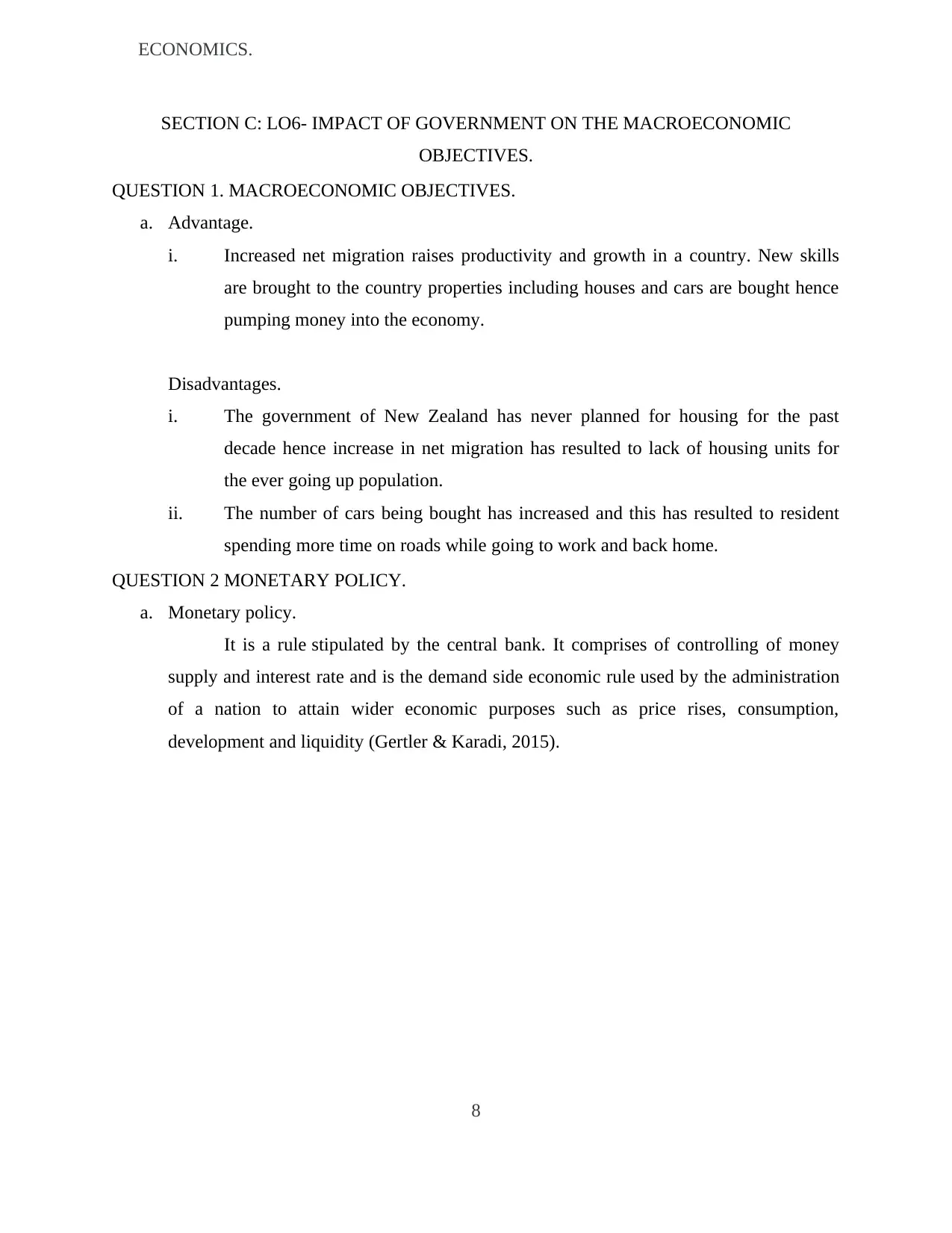
ECONOMICS.
SECTION C: LO6- IMPACT OF GOVERNMENT ON THE MACROECONOMIC
OBJECTIVES.
QUESTION 1. MACROECONOMIC OBJECTIVES.
a. Advantage.
i. Increased net migration raises productivity and growth in a country. New skills
are brought to the country properties including houses and cars are bought hence
pumping money into the economy.
Disadvantages.
i. The government of New Zealand has never planned for housing for the past
decade hence increase in net migration has resulted to lack of housing units for
the ever going up population.
ii. The number of cars being bought has increased and this has resulted to resident
spending more time on roads while going to work and back home.
QUESTION 2 MONETARY POLICY.
a. Monetary policy.
It is a rule stipulated by the central bank. It comprises of controlling of money
supply and interest rate and is the demand side economic rule used by the administration
of a nation to attain wider economic purposes such as price rises, consumption,
development and liquidity (Gertler & Karadi, 2015).
8
SECTION C: LO6- IMPACT OF GOVERNMENT ON THE MACROECONOMIC
OBJECTIVES.
QUESTION 1. MACROECONOMIC OBJECTIVES.
a. Advantage.
i. Increased net migration raises productivity and growth in a country. New skills
are brought to the country properties including houses and cars are bought hence
pumping money into the economy.
Disadvantages.
i. The government of New Zealand has never planned for housing for the past
decade hence increase in net migration has resulted to lack of housing units for
the ever going up population.
ii. The number of cars being bought has increased and this has resulted to resident
spending more time on roads while going to work and back home.
QUESTION 2 MONETARY POLICY.
a. Monetary policy.
It is a rule stipulated by the central bank. It comprises of controlling of money
supply and interest rate and is the demand side economic rule used by the administration
of a nation to attain wider economic purposes such as price rises, consumption,
development and liquidity (Gertler & Karadi, 2015).
8
Paraphrase This Document
Need a fresh take? Get an instant paraphrase of this document with our AI Paraphraser
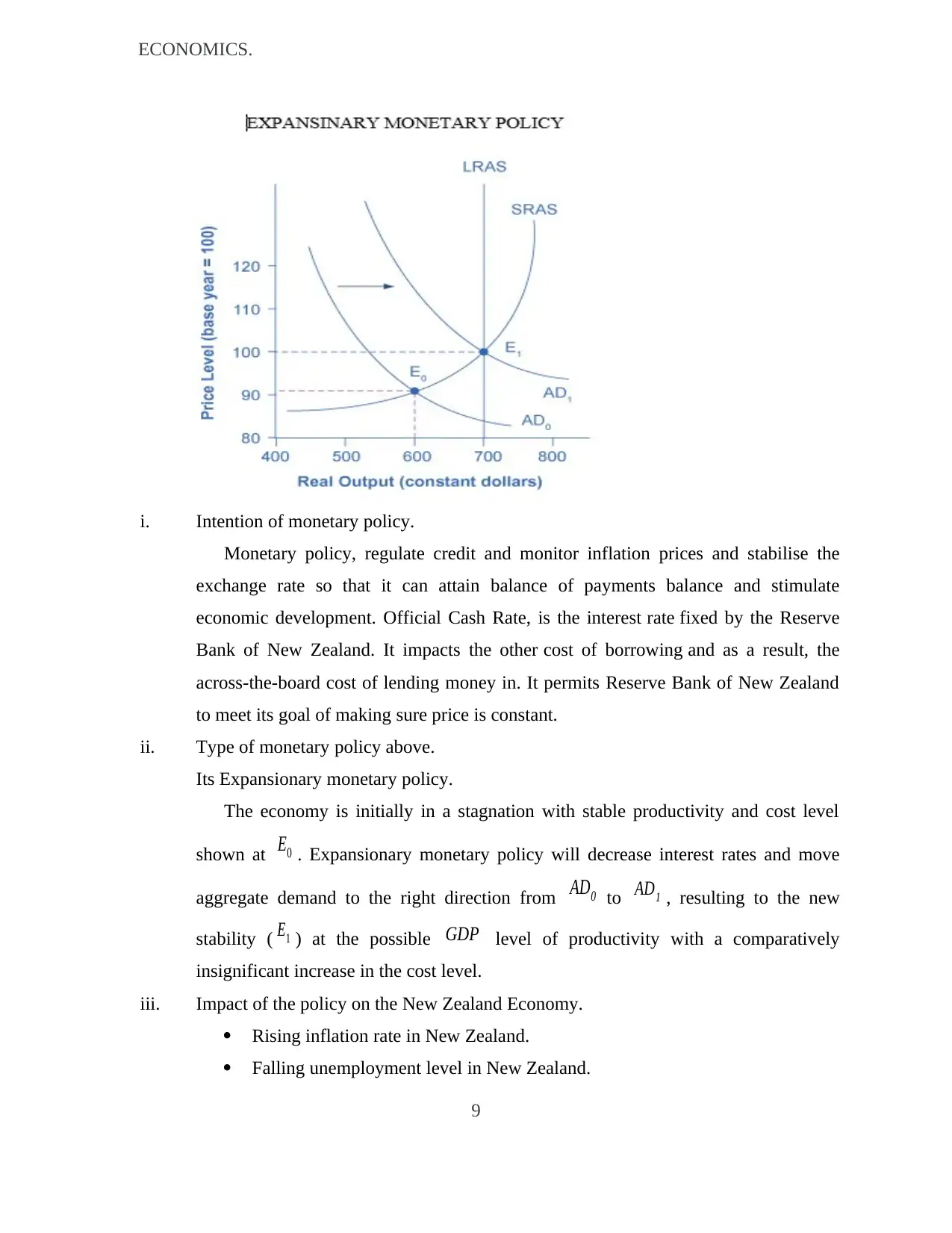
ECONOMICS.
i. Intention of monetary policy.
Monetary policy, regulate credit and monitor inflation prices and stabilise the
exchange rate so that it can attain balance of payments balance and stimulate
economic development. Official Cash Rate, is the interest rate fixed by the Reserve
Bank of New Zealand. It impacts the other cost of borrowing and as a result, the
across-the-board cost of lending money in. It permits Reserve Bank of New Zealand
to meet its goal of making sure price is constant.
ii. Type of monetary policy above.
Its Expansionary monetary policy.
The economy is initially in a stagnation with stable productivity and cost level
shown at E0 . Expansionary monetary policy will decrease interest rates and move
aggregate demand to the right direction from AD0 to AD1 , resulting to the new
stability ( E1 ) at the possible GDP level of productivity with a comparatively
insignificant increase in the cost level.
iii. Impact of the policy on the New Zealand Economy.
Rising inflation rate in New Zealand.
Falling unemployment level in New Zealand.
9
i. Intention of monetary policy.
Monetary policy, regulate credit and monitor inflation prices and stabilise the
exchange rate so that it can attain balance of payments balance and stimulate
economic development. Official Cash Rate, is the interest rate fixed by the Reserve
Bank of New Zealand. It impacts the other cost of borrowing and as a result, the
across-the-board cost of lending money in. It permits Reserve Bank of New Zealand
to meet its goal of making sure price is constant.
ii. Type of monetary policy above.
Its Expansionary monetary policy.
The economy is initially in a stagnation with stable productivity and cost level
shown at E0 . Expansionary monetary policy will decrease interest rates and move
aggregate demand to the right direction from AD0 to AD1 , resulting to the new
stability ( E1 ) at the possible GDP level of productivity with a comparatively
insignificant increase in the cost level.
iii. Impact of the policy on the New Zealand Economy.
Rising inflation rate in New Zealand.
Falling unemployment level in New Zealand.
9

ECONOMICS.
QUESTION 3. FISCAL POLICY.
It is the process by which a regime of the day regulates their expenditure and tax rates to
observe and impact a country's economy. Under the policy, the Reserve bank influences a
country's amount of money in circulation (O'connor, 2017).
i. Intention of fiscal policy.
Fiscal policy is the method in which a government regulates its spending margin and
tax amounts to observe and impact on country’s economy.
10
QUESTION 3. FISCAL POLICY.
It is the process by which a regime of the day regulates their expenditure and tax rates to
observe and impact a country's economy. Under the policy, the Reserve bank influences a
country's amount of money in circulation (O'connor, 2017).
i. Intention of fiscal policy.
Fiscal policy is the method in which a government regulates its spending margin and
tax amounts to observe and impact on country’s economy.
10
⊘ This is a preview!⊘
Do you want full access?
Subscribe today to unlock all pages.

Trusted by 1+ million students worldwide
1 out of 19
Related Documents
Your All-in-One AI-Powered Toolkit for Academic Success.
+13062052269
info@desklib.com
Available 24*7 on WhatsApp / Email
![[object Object]](/_next/static/media/star-bottom.7253800d.svg)
Unlock your academic potential
Copyright © 2020–2025 A2Z Services. All Rights Reserved. Developed and managed by ZUCOL.




